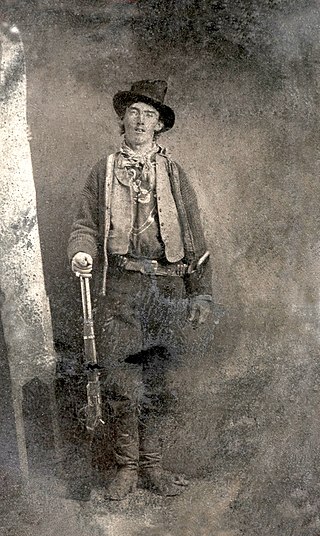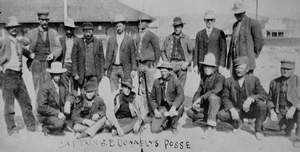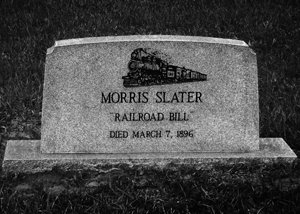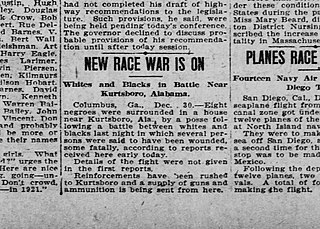Related Research Articles

The Lincoln County War was an Old West conflict between rival factions which began in 1878 in Lincoln County, New Mexico Territory, the predecessor of the state of New Mexico, and continued until 1881. The feud became famous because of the participation of William H. Bonney. Other notable participants included Sheriff William J. Brady, cattle rancher John Chisum, lawyer and businessmen Alexander McSween, James Dolan and Lawrence Murphy.

The Wild Bunch, also known as the Doolin–Dalton Gang, or the Oklahombres, were a gang of American outlaws based in the Indian Territory in the late 19th and early 20th centuries. They were active in Kansas, Missouri, Arkansas, and Oklahoma Territory during the 1890s—robbing banks and stores, holding up trains, and killing lawmen. They were also known as The Oklahoma Long Riders because of the long dusters that they wore.

Harry Tracy was an outlaw in the American Old West.

The Earp Vendetta Ride was a deadly search by a federal posse led by Deputy U.S. Marshal Wyatt Earp for a loose confederation of outlaw "Cowboys" they believed had ambushed his brothers Virgil and Morgan Earp, maiming the former and killing the latter. The two Earp brothers had been attacked in retaliation for the deaths of three Cowboys in the Gunfight at the O.K. Corral on October 26, 1881. From March 20 to April 15, 1882, the federal posse searched southeast Cochise County, Arizona Territory for the men they believed were responsible for the attacks on Virgil and Morgan. Several suspects had been identified and were charged, but were soon released by the court, owing in some cases to legal technicalities and in others to the strength of alibis provided by Cowboy confederates. Wyatt hoped that the legal system would bring the Cowboys to justice, but after suspects in both ambushes were freed, Wyatt resolved to take matters into his own hands.

Harvey Alexander Logan, also known as Kid Curry, was an American outlaw and gunman who rode with Butch Cassidy and the Sundance Kid's infamous Wild Bunch gang during the late 19th and early 20th centuries. Despite being less well-known than his fellow gang members, he has since been referred to as "the wildest of the Wild Bunch", having reputedly killed at least nine law enforcement officers in five shootings and another two men in other instances. He was involved in numerous shootouts with police and civilians and participated in several bank and train robberies with various gangs during his outlaw days.

Frank M. Canton was an American Old West fugitive who had a career as a deputy U.S. marshal under an assumed name. Although an ex-sheriff stock detective in Wyoming, Canton and his associates were accused of operating more by assassination than the law. Extrajudicial measures such as the lynching of Ellen Watson inflamed public opinion against the long-established big ranchers Canton worked for, and to re-establish control over grazing they funded an all-out assault on those small operators considered to be rustlers. Canton directed Frank Wolcott's imported gunmen in their planned vigilante campaign, known as the Johnson County War, which was quickly ended by a local posse. Finding himself a marked man in Wyoming, Canton considered it opportune to leave the state. He spent most of the rest of his working life in law enforcement for the court of hanging judge Isaac Parker.
The Goingsnake Massacre refers to the eleven victims of a fatal shootout on April 15, 1872, that broke out during a murder and assault trial in the Cherokee court in the Goingsnake District of the Cherokee Nation The dead included three Cherokee on the defendant's side, including his attorney and a brother; a US Deputy Marshal and four members of his federal posse, plus three relatives of the Cherokee murder victim. Another ten men were wounded, including both Cherokee and white men.

William Larkin Stiles, better known as Billy Stiles or William Larkin, was an American outlaw in the Old West who, with partner Burt Alvord, led a small gang of train robbers while serving as a deputy sheriff in Arizona Territory.
The Jack Taylor Gang was an outlaw gang of the Old West which operated mostly in Arizona Territory and Mexico.
The History of the Los Angeles County Sheriff's Department began with its founding in 1850 as the first professional police force in the Los Angeles area.

On March 10, 2009, Michael Kenneth McLendon, 28, fatally shot ten people and wounded six others between the communities of Kinston, Samson, and Geneva, Alabama. McLendon's shooting spree was the deadliest mass shooting in Alabama's history.

The Cochise County Cowboys is the modern name for a loosely associated group of outlaws living in Pima and Cochise County, Arizona in the late 19th century. The term "cowboy", as opposed to "cowhand," had only begun to come into wider usage during the 1870s. In that place and time, "cowboy" was synonymous with "cattle rustler". Such thieves frequently rode across the border into Mexico and stole cattle from Mexican ranches that they then drove back across the border to sell in the United States. Some modern writers consider them to be an early form of organized crime in America.
Harmon Murray was an African-American who briefly achieved notoriety in 1890 and 1891 as the reputed leader of a feared criminal gang in northern Florida, and for killing a number of men, including a sheriff and a deputy sheriff, before being killed himself by an acquaintance.

The Battle of Kelley Creek, also known as the Last Massacre, is often considered to be one of the last known massacres carried out between Native Americans and forces of the United States, and was a closing event to occur near the end of the American Indian warfare era. In January 1911 a small band of Shoshones were accused of rustling cattle and then killing four stockmen who went to investigate the dead cattle. A posse of policemen and citizens was sent to track the band, who were found encamped near Winnemucca, Nevada, in a region known as Kelley Creek. A largely one-sided battle ensued on February 25 that ended with the direct deaths of nine people, eight Daggetts and one posse member. At the time the affair was briefly characterized as a Native American revolt, though it is now mostly regarded as a family's attempted escape from law enforcement.

Feuds in the United States deals with the phenomena of historic blood feuding in the United States. These feuds have been numerous and some became quite vicious. Often, a conflict which may have started out as a rivalry between two individuals or families became further escalated into a clan-wide feud or a range war, involving dozens—or even hundreds—of participants. Below are listed some of the most notable blood feuds in United States history, most of which occurred in the Old West.

The Blackwell gunfight occurred on the morning of December 4, 1896, when a posse of American lawmen confronted two bandits at their hideout near Blackwell, Oklahoma. During a lengthy shootout that followed, Deputy Alfred O. Lund killed an outlaw named Dick Ainsley while the other outlaw, Ben Cravens, was badly wounded and captured.

Morris Slater was an African American, notable for his dramatic escapes from the law in the style of Robin Hood. He acquired the name Railroad Bill. Although there was a price on his head for some years, he evaded capture through ingenuity and exceptional athletic abilities. He was eventually shot dead in an ambush at a store he was known to visit. Slater is celebrated in the folk-ballad Railroad Bill, which has been recorded by numerous artists, including Lonnie Donegan, Taj Mahal, Bob Dylan, Joan Baez, Andrew Bird, Roger McGuinn, Doc Watson, and Dave Alvin.

The Hurtsboro race riot was conflict between Black and White residents of Hurtsboro, Alabama in the final days of 1920.
References
- ↑ Desperado kills three, The New York Times (April 7, 1902)
- ↑ Three died from wounds, The New York Times (April 8, 1902)
- ↑ Three of the Wounded Dead, The Hartford Courant (April 8, 1902)
- ↑ Negro slays white men, The Racine Journal (April 8, 1902)
- ↑ Death of late sheriff's wife spurs memory tragedy that rocked south, TimesDaily (July 23, 1958)
- ↑ 'Colbert's worst tragedy' occurred 70 years ago, TimesDaily (June 24, 1971)
- ↑ A job well-done, TimesDaily (May 17, 1996)
- 1 2 3 "Attack on William Reynolds by Tuscumbia sheriff burns two houses". Richmond Planet . 12 April 1902. p. 1. Retrieved 7 January 2023.
- 1 2 "Desperado Kills Five". The Montgomery Advertiser . 8 April 1902. p. 1. Retrieved 7 January 2023.
- ↑ Deadliest Days in Law Enforcement History, National Law Enforcement Officers Memorial Fund
- ↑ Five dead and two dying, The Indianapolis Journal (April 8, 1902)